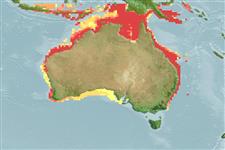>
Scombriformes (Mackerels) >
Scombridae (Mackerels, tunas, bonitos) > Scombrinae
Etymology: Scomberomorus: Latin, scomber = mackerel + Greek, moros = silly, stupid (Ref. 45335).
Environment: milieu / climate zone / depth range / distribution range
Écologie
marin; océanodrome (Ref. 51243); profondeur ? - 100 m (Ref. 6390). Tropical; 6°S - 38°S, 110°E - 157°E (Ref. 168)
Western Pacific: restricted to the northern coast of Australia, from the Abrolhos Islands region of Western Australia to Coffs Harbor and Kempsey in central New South Wales; also occurring in southern Papua New Guinea from Kerema to Port Moresby.
Length at first maturity / Taille / Poids / Âge
Maturity: Lm ?, range 61 - ? cm
Max length : 104 cm FL mâle / non sexé; (Ref. 6390); poids max. publié: 10.2 kg (Ref. 3132)
Épines dorsales (Total): 20 - 22; Rayons mous dorsaux (Total): 17-20; Épines anales 0; Rayons mous anaux: 17 - 19; Vertèbres: 50 - 52. Interpelvic process small and bifid. Lateral line gradually curving down toward caudal peduncle. Intestine with 2 folds and 3 limbs. Swim bladder absent. Body covered with small scales. Sides with several poorly defined rows of round spots, larger than pupil but smaller than eye diameter. The inner surface of the pectoral fin is dark blue, the cheeks and belly silvery white, the anal fin and anal finlets light silvery gray, and the dorsal fin black, bright steely blue when fresh.
Found more commonly in offshore, open waters away from reefs and shoals (Ref. 30199). Form large schools which move close inshore along the coast of Queensland, commonly taken between December and April or May. Feed largely on fishes, particularly anchovies and sardines with smaller quantities of shrimps and squids. Common fork length ranges between 50 to 80 cm (Ref. 168). Sometimes confused with S. niphonius.
Life cycle and mating behavior
Maturité | Reproduction | Frai | Œufs | Fécondité | Larves
Collette, B.B. and C.E. Nauen, 1983. FAO Species Catalogue. Vol. 2. Scombrids of the world. An annotated and illustrated catalogue of tunas, mackerels, bonitos and related species known to date. Rome: FAO. FAO Fish. Synop. 125(2):137 p. (Ref. 168)
Statut dans la liste rouge de l'IUCN (Ref. 130435)
Menace pour l'homme
Reports of ciguatera poisoning (Ref. 6390)
Utilisations par l'homme
Pêcheries: commercial; pêche sportive: oui
Plus d'informations
RéférencesAquacultureProfil d'aquacultureSouchesGénétiqueElectrophoresesHéritabilitéPathologiesTraitementNutrientsMass conversion
Outils
Articles particuliers
Télécharger en XML
Sources Internet
Estimates based on models
Preferred temperature (Ref.
123201): 22.5 - 28.6, mean 27.5 °C (based on 574 cells).
Phylogenetic diversity index (Ref.
82804): PD
50 = 0.5000 [Uniqueness, from 0.5 = low to 2.0 = high].
Bayesian length-weight: a=0.00832 (0.00383 - 0.01808), b=3.03 (2.86 - 3.20), in cm total length, based on LWR estimates for this Genus-body shape (Ref.
93245).
Niveau trophique (Ref.
69278): 4.3 ±0.76 se; based on food items.
Résilience (Ref.
120179): Milieu, temps minimum de doublement de population : 1,4 à 4,4 années (K=0.23-0.46; tm=1-2; tmax=7).
Fishing Vulnerability (Ref.
59153): Moderate vulnerability (36 of 100).
